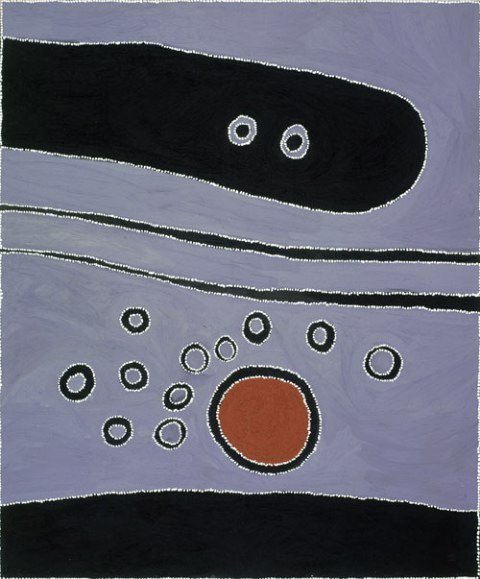Remembering Forward
dal 18/11/2010 al 19/3/2011
Segnalato da
Paddy Bedford
Emily Kame Kngwarreye
Queenie Mckenzie
Dorothy Napangardi
Rover Thomas
Ronnie Tjampitjinpa
Clifford Possum Tjalpaltjarri
Tim Leura Tjapaltjarri
Turkey Tolson Tjupurrula
Binyinyuwuy
Tom Djawa
Gunguyuma Lipundja
Samuel Lipundja
Kasper Konig
Emily Evans
Falk Wolf
18/11/2010
Remembering Forward
Museum Ludwig, Koln
The exhibition presents works by nine outstanding artists whose work spans the last 40 years of contemporary Australian Indigenous painting in the Central and Western Deserts and the Kimberley region. Contemporary Aboriginal art, despite regional differences, has two central characteristics: the artists' binding relationships to their traditions and myths on one hand, and a visual language that appears highly modern to Western viewers on the other.

Paddy Bedford, Emily Kame Kngwarreye, Queenie Mckenzie, Dorothy Napangardi, Rover Thomas, Ronnie Tjampitjinpa, Clifford Possum Tjalpaltjarri, Tim Leura Tjapaltjarri, Turkey Tolson Tjupurrula as well as works on bark by Binyinyuwuy, Tom Djawa, Gunguyuma and Samuel Lipundja from the Art Gallery of New South Wales.
Curators: Prof. Kasper König, Emily Evans, Falk Wolf
In the exhibition "Remembering Forward", the Museum Ludwig will present works by nine outstanding artists whose work spans the last forty years of contemporary Australian Indigenous painting in the Central and Western Deserts and the Kimberley region. Bark paintings from Arnhem Land will complement this selection. These works were acquired by Tony Tuckson and Stuart Scougall for the Art Gallery of New South Wales around 1960, thus receiving early recognition as equals of Western works of art. Contemporary Aboriginal art, despite regional differences, has two central characteristics: the artists' binding relationships to their traditions and myths on one hand, and a visual language that appears highly modern to Western viewers on the other. The paintings thus exist within a peculiar tension between tradition and modernity, past and present, and localization and globalization. The themes of the exhibited images typically refer to "Dreamtime" stories, that is, stories from the mythological time in which the land and all living things were created. In Aboriginal culture, the Dreamtime encompasses past, present and future. Since the early 1970s, artists have increasingly made use of modern materials such as acrylic paints and canvas. Their visualized Dreamings thus left the realm of ritual and were bought and sold by galleries and collected by museums. In this way, the artists became significant intercultural ambassadors who also decisively influenced the process of receiving civil and land rights. In working with the new materials, many artists arrived at highly innovative visual forms that, at first glance, recall abstract Western painting. At the same time, however, they are concrete realizations of the land, and they show the connection of land and Dreaming on a direct and sensual level. Some artists, those from the Kimberley in particular, have also depicted the cruelties that accompanied their land's colonization.
For Western viewers these paintings represent a new challenge to established modes of looking and understanding. That which appears to be an abstract image must in fact be understood as the depiction of a place and its history. The artists often make use of a visual technique that has no horizon line, instead showing the land from above. Layers of paint can also be layers of time. Yet these works cannot be understood purely emblematically, or classified by their iconography. Some artists have transformed their references to body painting or sense of the land into strong colours and gestural brushstrokes, thus distancing themselves from any specific narratives. But a complex and specifically Indigenous way of dealing with a place's and the world's structure, time and space, narration and abstraction, showing and hiding, is always visible. This radical consideration and reworking of painting's possibilities makes these works central contributions to contemporary art.
An English edition of the catalogue will be published by Paul Holberton Publishing.
Image: Paddy Bedford, Two Women Looking at the Bedford Downs Massacre Burning Place, 2002, Private Collection, © Paddy Bedford Estate
Press and Public Relations
Valeska Schneider Tel +49-221-221-23491 fax+49-221-221-24114 E-Mail schneider@museum-ludwig.de
Opening 19 November 2010, at 19
Museum Ludwig
Heinrich-Böll-Platz, 50667 Köln
Opening hours
Tuesday to Sunday (incl. public holidays): 10 a.m. to 6 p.m.
Every first Thursday of the month 10 a.m. to 10 p.m.
Closed on Monday
Admission
All tickets are valid the whole day long and grant admission to the collections and all special exhibitions.
Adults: € 10, concessions: € 7 (Children under 14, school students, college students, trainees (Azubis), military/alternative service conscripts on production of a valid ID, owners of the "Köln-Pass")
Families: € 20,00
Groups (20 people and over): € 7.50 per person
School classes incl. teacher: free entrance to the collection
€ 4 per pupil/teacher for the special exhibition



